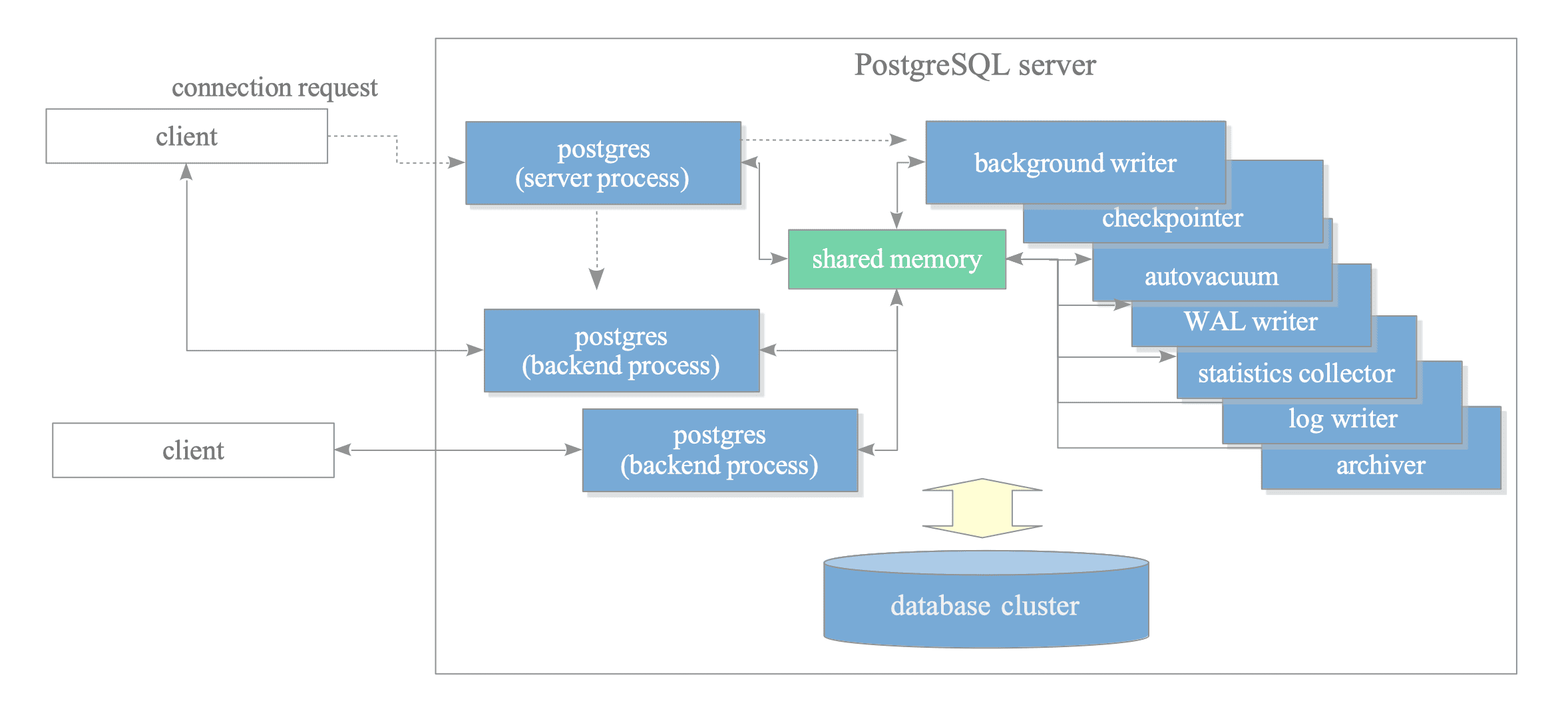2.1. Process Architecture
PostgreSQL is a client/server type relational database management system with a multi-process architecture that runs on a single host.
A collection of multiple processes that cooperatively manage a database cluster is usually referred to as a ‘PostgreSQL server’. It contains the following types of processes:
- The postgres server process is the parent of all processes related to database cluster management.
- Each backend process handles all queries and statements issued by a connected client.
- Various background processes perform processes perform tasks for database management, such as VACUUM and CHECKPOINT processing.
- Replication-associated processes perform streaming replication. More details are described in Chapter 11.
- Background worker processes supported from version 9.3, it can perform any processing implemented by users. For more information, refer to the official document.
In the following subsections describe the details of the first three types of processes.

Figure 2.1. An example of the process architecture in PostgreSQL.
This figure shows processes of a PostgreSQL server: a postgres server process, two backend processes, seven background processes, and two client processes. The database cluster, the shared memory, and two client processes are also illustrated.
2.1.1. Postgres Server Process
As mentioned earlier, the postgres server process is the parent of all processes within a PostgreSQL server. In earlier versions, it was referred to as postmaster.
When the pg_ctl utility is executed with the start option, the postgres server process starts.
It then allocates a shared memory area, initiates various background processes, starts replication-related processes and background worker processes as needed, and waits for connection requests from clients. When a connection request is received, it spawns a backend process to handle the client session.
A postgres server process listens to one network port, the default port is 5432. Although more than one PostgreSQL server can be run on the same host, each server must be set to listen to different port number, such as 5432, 5433, and so on.
2.1.2. Backend Processes
A backend process, also called a postgres process, is started by the postgres server process and handles all queries issued by one connected client. It communicates with the client using a single TCP connection and terminates when the client disconnects.
Each backend process can only operate on one database at a time, requiring explicit database selection during connection.
PostgreSQL supports concurrent connections from multiple clients, with the maximum number controlled by the max_connections configuration parameter (default: 100).
If many clients, such as WEB applications, frequently connect and disconnect from a PostgreSQL server, it can increase the cost of establishing connections and creating backend processes, as PostgreSQL does not have a native connection pooling feature.
This can have a negative impact on the performance of the database server.
To deal with such a case, a connection pooling middleware such as pgbouncer or pgpool-II is usually used.
2.1.3. Background Processes
Table 2.1 shows a list of background processes.
In contrast to the postgres server process and the backend process, it is impossible to explain each of the functions simply. This is because these functions depend on the individual specific features and PostgreSQL internals.
Therefore, in this chapter, only introductions are made. Details will be described in the following chapters.
| process | description | reference |
|---|---|---|
| background writer | This process writes dirty pages on the shared buffer pool to a persistent storage (e.g., HDD, SSD) on a regular basis gradually. (In versions 9.1 or earlier, it was also responsible for the checkpoint process.) | Section 8.6 |
| checkpointer | This process performs the checkpoint process in versions 9.2 or later. | Section 8.6, Section 9.7 |
| autovacuum launcher | This process periodically invokes the autovacuum-worker processes for the vacuum process. (More precisely, it requests the postgres server to create the autovacuum workers.) | Section 6.5 |
| WAL writer | This process writes and flushes the WAL data on the WAL buffer to persistent storage periodically. | Section 9.6.1 |
| WAL Summarizer | This process tracks changes to all database blocks and writes these modifications to WAL summary files. Introduced in version 17. | Section 9.6.2 |
| statistics collector | This process collects statistics information such as for pg_stat_activity and pg_stat_database, etc. | |
| logging collector (logger) | This process writes error messages into log files. | |
| io worker | These processes handle read operations asynchronously, offloading I/O tasks from regular backend processes. (Asynchronous I/O has been introduced since version 18 to improve I/O performance.) | |
| archiver | This process executes archiving logging. | Section 9.10 |
The actual processes of a PostgreSQL server are shown below.
In the following example, there is one postgres server process (pid is 6541), two backend processes (pids are 8412 and 8482), and several background processes listed in Table 2.1. See also Figure 2.1.
$ pstree -p 6541
-+= 00001 root /sbin/launchd
\-+= 06541 postgres /usr/local/pgsql/bin/postgres -D data
|--= 06542 postgres postgres: io worker 0
|--= 06543 postgres postgres: io worker 1
|--= 06544 postgres postgres: io worker 2
|--= 06545 postgres postgres: checkpointer
|--= 06546 postgres postgres: background writer
|--= 06548 postgres postgres: walwriter
|--= 06549 postgres postgres: autovacuum launcher
|--= 06550 postgres postgres: walsummarizer
|--= 06551 postgres postgres: logical replication launcher
|--= 08412 postgres postgres: postgres testdb [local] idle
\--= 08482 postgres postgres: postgres testdb [local] idle in transaction